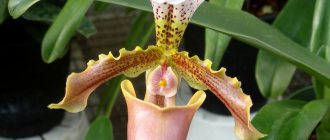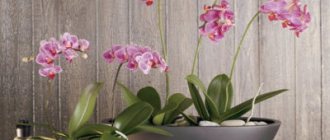This technique is competitive, and now experienced gardeners are using it in practice when growing orchids.
In order for the plant to develop well, must be properly planted in a closed system and further care must follow all the rules. This method of growing has its pros and cons, we will look at them in more detail below.
Landing
Sometimes a closed system is a salvation for Phalaenopsis or another type of orchid. Since greenhouse conditions are created in the system , which help restore the root system of the flower.
Selection of capacity
The container for planting the plant can be made of plastic or glass, but it is worth noting that the plastic container is more durable and lightweight, and it can be converted into an ordinary container for standard cultivation of orchids if the grower cannot master the new method for some reason.
Glass containers have a more decorative appearance and now you can see different shapes in stores:
- square containers;
- glasses of different sizes;
- flowerpots and flowerpots.
Square pots of different sizes.
The main thing is that glass flowerpots are heavier, which means they are more stable. When choosing a container, you should also pay attention to its shape. It should expand towards the top . This form will not prevent the evaporation of moisture after watering.
Substrate preparation
The composition of the soil remains the same as when cultivating orchid plants in the usual way:
- expanded clay;
- charcoal;
- pine bark with a fraction size of no more than 1x2 cm;
- sphagnum moss.
IMPORTANT! The main difference is that the components are not mixed, but laid out in layers in a closed container.
Disinfection
All soil must be disinfected by keeping it in the freezer of the refrigerator for two days. This will help get rid of various parasites that may be found in the bark and coconut fibers.
It will not work in the oven, as the bark can simply burn at high temperatures.
Disinfection is necessary, since soil located in a closed system can be susceptible to fungal diseases with high humidity.
Step by Step Actions
Any gardener, even a beginner, can handle planting in a closed system. You just need to follow the basic recommendations:
- The container, regardless of the material, is doused with boiling water for the purpose of disinfection. This is not an extra step and it is not recommended to skip it, especially if the container is used for a second time;
- A layer of expanded clay is placed on the bottom of the glass at ¼ of the height of the container;
- A centimeter layer of sphagnum moss is placed on it;
- In the remaining free part, lay out bark and charcoal;
- The entire contents are filled with water and allowed to stand for about half an hour ;
- After draining the water, take out a part of the bark and plant the orchid, filling the empty areas between the roots with pine bark;
- Finally, moss is placed on the surface so that it does not touch the plant trunk . This will protect the flower from rotting.
Phalaenopsis in a closed system.
Following this recommendation, the flower will be planted in a closed container according to all the rules; further care does not differ from the basic care of orchids.
IMPORTANT! In a closed system, only plants with healthy foliage and a well-developed root system can be cultivated.
How to choose a pot?
The most common flowers in home greenhouses are epiphytic orchids. The main feature of such plants is the presence of an aerial root system. It participates in photosynthesis along with foliage and is in dire need of oxygen, light and moisture.
The presence of such features makes choosing a container for planting an orchid one of the most important tasks for a grower:
- Clay and ceramic pots. Unsuitable container for the normal existence of epiphytes. The blank walls of such dishes do not allow light and air to pass through. Because of this, the root system is not able to fully function. The roots grow to the uneven walls of the clay pot. A poorly drying substrate can cause root rot.
- Glass flowerpots. Not the best option for orchids, despite its aesthetic appeal. They have poor ventilation of the substrate and limited access of oxygen to the roots. In addition, the glass walls of the pot can refract sunlight in such a way that the root system will receive a serious burn.
- Wicker baskets. They are able to provide the required air circulation, but the root system will not receive enough light.
- Plastic pots. An ideal container for epiphytes, but only if there are the required number of holes on the walls and bottom of such a pot. Perforated clear plastic planters provide access to the right amount of light and air. Through the walls of such a container you can monitor the condition of the root system.
Important! The diameter of the pot for planting an orchid should be a couple of centimeters larger than the root system.
There is a technique for growing epiphytic orchids on blocks, which are pieces of bark or wood cuts. This method allows you to create conditions close to natural. The main disadvantage is serious changes in humidity. Since it is impossible to maintain the required level of moisture in the air within the apartment.
Care
In order for a flower to live and develop well in a closed system, it needs to be properly cared for throughout its entire life.
Watering
If the bark and other components of the soil were soaked before planting, then the plant does not need watering in the first 10 days. This can be seen on the walls of the container, since there are still droplets of water on it, indicating that there is still enough moisture in the closed pot.
The main sign that watering is necessary will be the disappearance of condensation on the inner walls of the vessel and a change in the color of the roots. They will turn from green to light gray.
Two watering methods:
- Using immersion, water is poured into a container so that only the root collar remains outside of watering. Water for 15-20 minutes, after which the water is drained by tilting the container and holding the soil with your hand;
- It consists in the fact that water is constantly poured into containers at the level of expanded clay and is not drained after watering. This method requires timely addition of water when it evaporates.
IMPORTANT! When choosing a watering method, the gardener focuses on the temperature in the room where the orchid grows. Since at low temperatures, constantly pouring water can contribute to rotting of the root system.
Features of feeding
The main difference is more rare feeding with small doses of fertilizers. This is explained by the fact that all fertilizers poured into the container with the plant remain there. Therefore, the dose is reduced by 10 times so as not to burn the root system of the plant.
And the regime is reduced several times, alternating fertilizers with irrigation with ordinary water.
In a closed system, fertilizing is done less frequently and in lower concentrations.
Possible problems
Sometimes, if not properly cared for, an orchid may die. To prevent this from happening, you must avoid mistakes in caring for the plant:
- If the plant is watered with cold water or too often, the result will be rotting of the root mass - the orchid is removed from the container and the roots are treated. After complete drying, after 5 days they are planted in their original place;
- From frequent watering, small white midges sometimes appear in the bark . In this case, watering is reduced, drying the soil. After complete drying, the midges disappear;
- green algae , which appear on the inner walls of the pot over time. If there are too many of them, the flower and soil are removed, and the container is washed and sterilized. After this, it is suitable for planting.
Possible problems
If you follow the rules of agricultural technology, difficulties should not arise. However, flower growers often face the following problems:
- If you use a container that is too deep, the flower simply dries out, because... the root system is located far from moisture.
- Mold appears inside the container. There is no need to be afraid of it during adaptation. In 90% of cases, the mold disappears on its own without any consequences when the orchid takes root.
- The use of excessively small bark particles causes root rot. After all, wet dust becomes compact and does not allow air to pass through. The substrate must consist of sufficiently large components.
- If you water the flower very often, and even with cold water, rotting of the roots cannot be avoided.
- A humid environment attracts pests. They get rid of them using special insecticides or garlic water. White midges will disappear if you reduce watering and dry the substrate.
- A green coating gradually appears on the walls of the pot. It spoils the appearance, but it is impossible to prevent its formation.
Important!
If areas affected by rot are found, the plant should be removed from the substrate and washed. Rotten roots are cut off, powdered with activated carbon and dried for 3-4 days. Then the flower is planted in a new substrate and the watering regime is changed.
Reanimation
Sometimes inexperienced gardeners end up with an orchid without roots for a number of reasons. Planting such a flower in a closed system often helps to completely grow young roots on the bush .
In a closed system, a microclimate is established that resembles a greenhouse with its high humidity. It is almost identical to the conditions under which the flower grows in its homeland. a number of factors affecting the formation of roots in an orchid are met
- the room temperature should not fall below 25 degrees Celsius;
- there should be a lot of diffused sunlight;
- There should be no direct sunlight at all.
A closed system is often used to resuscitate rootless orchids.
The resuscitation time depends on how damaged the plant is; sometimes it takes a month, and sometimes a year, for resuscitation.
Plant adaptation
Their adaptation depends on the degree of impact on the root system. If the plant has undergone a radical operation to trim dry or rotten roots, it will have a hard time with replanting. To prevent this from happening, you need to adhere to simple rules, namely: the flower should be replanted when it is in the growth phase and at the same time leave part of the old substrate. There is no need to feed immediately, it will only do harm.
Also, during the adaptation period, the plant may dry out the lower leaves or drop flowers; this is a normal reaction of a flower getting used to its new place of residence.
Reviews of the closed landing system
According to reviews of flower growers who grew orchids using this method:
- the orchid grows roots well after drying out;
- the flooded flower must first be dried for a week and only then planted in a closed system;
- in such a closed container, children grow their root system well ;
- When cultivating a flower in this way, you need to carefully monitor the watering regime;
- an orchid does not always develop well in a closed system and it is not clear why its leaves and roots begin to die, then it is worth trying to grow it in the usual way.
There are so many orchid lovers, so many opinions, you just need to try a new method, and maybe the flower will adapt well to it and grow flower stalks.
The main difficulties in cultivation
When cultivating orchids using this method, gardeners most often encounter mold. At first it almost always appears, but as the plants adapt, it disappears.
Insects often appear on a moist substrate and diseases develop. The fight against them involves both the use of traditional methods and the improvement of cultivation conditions and bringing them back to normal.
Gardeners often use excessively voluminous containers for cultivation, in which the plants dry out. This happens because the roots are too short to reach the water. This issue should be approached more carefully.
Why does an indoor orchid rot at the base of the leaves (root collar)
This occurs for the following reasons:
- Low temperature in the ground.
- Excessive application of fertilizer with high nitrogen content.
- Excessive watering, frequent spraying and high air humidity.
- Poor drying of the soil between waterings.
- The cause may be damage to the orchid by pests.
- Fungal diseases (fusarium, bacterial rot).
- Improper planting of a plant in a pot - excessive deepening.
- Poor substrate (old, caked, salted or highly acidic).
Photo by O. Nikonorova: The root collar may suffer due to stagnant moisture in the pot.
Methods for preventing the appearance of rot on orchids
It is easier to prevent a problem than to deal with its consequences later. For prevention purposes, we recommend:
- Regularly inspect the plant from all sides.
- The substrate must be heat treated before use. Old, caked substrate must be replaced with a new one in a timely manner.
- Irrigation using the immersion method. This is when the pot is immersed in water and left there so that all parts of the plant are saturated with moisture. Water only after the soil dries.
- Remove excess water from the leaf axils when watering and spraying.
- Feed on time and follow the dosage recommended by the manufacturer. It's always better to lower it a little.
- Place the orchid pot in light partial shade. If necessary, you need to install additional lighting with a phytolamp.
Now you know how to save a rotting orchid and return it to a healthy appearance. We wish you success in treating indoor beauties!
_____________________________________________________________________ Read our other articles about orchids: Lunar calendar for planting and replanting flowers for a year The leaves of an orchid are turning yellow: reasons and what a caring gardener should do to save the beauty How to plant a baby orchid at home for the sake of propagating an exotic flower 7 reasons why an orchid does not bloom, and how to make an exotic beauty bloom _______________________________________________________________________ What do you do when your orchids suddenly begin to rot? Share your recommendations with other gardeners in the comments!











